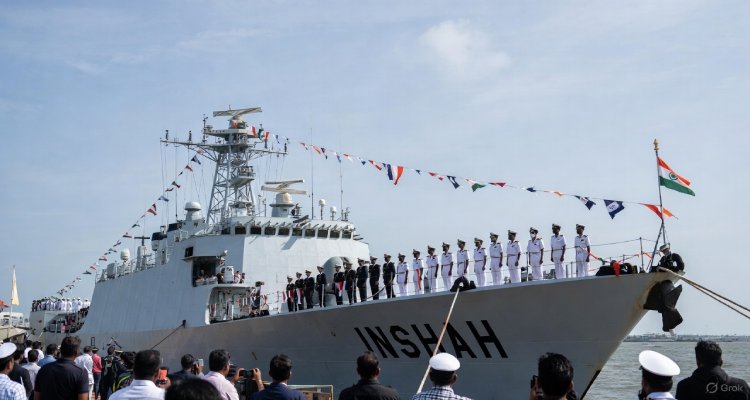Cabinet Clears ₹69,725 Crore Package to Revitalize India’s Shipbuilding and Maritime Sector
India approves a ₹69,725 crore package to boost shipbuilding, strengthen maritime infrastructure, and position the nation as a global shipping hub.
Introduction: Setting Sail on a Maritime Revival
In a landmark decision aimed at transforming India’s maritime future, the Union Cabinet chaired by Prime Minister Narendra Modi has approved a comprehensive ₹69,725 crore package to boost shipbuilding and the broader maritime ecosystem. This package, structured across four strategic pillars, represents India’s most ambitious attempt yet to reclaim its maritime legacy, strengthen national security, and propel itself into the ranks of global shipbuilding powers.
Context & Background: India’s Maritime Legacy and Current Challenges
For centuries, India’s coasts have connected the subcontinent to the world, from ancient trade networks in the Indian Ocean to modern global supply chains. Today, maritime transport remains the backbone of India’s economy, handling nearly 95% of trade by volume and 70% by value.
Yet, despite this reliance, India contributes just 0.06% to global shipbuilding output, ranking 20th worldwide. In comparison, East Asian nations like China, South Korea, and Japan dominate the industry. Recognizing the economic, strategic, and technological implications of this gap, the government has launched an integrated mission to reverse decades of underinvestment.
Main Developments: Breaking Down the ₹69,725 Crore Package
The Cabinet’s package is built around four pillars designed to address financing gaps, capacity bottlenecks, technology deficits, and policy challenges.
Pillar I: Shipbuilding Financial Assistance Scheme (SBFAS)
- Extended until March 31, 2036 with a corpus of ₹24,736 crore.
- Includes a Shipbreaking Credit Note worth ₹4,001 crore to incentivize green recycling and sustainable practices.
- Establishes a National Shipbuilding Mission to oversee initiatives and streamline implementation.
Pillar II: Maritime Development Fund (MDF)
- Corpus of ₹25,000 crore to provide long-term financing.
- Maritime Investment Fund of ₹20,000 crore, with 49% participation from the government.
- Interest Incentivisation Fund of ₹5,000 crore to lower borrowing costs and improve project viability.
Pillar III: Shipbuilding Development Scheme (SbDS)
- Budgetary outlay of ₹19,989 crore.
- Expands domestic capacity to 4.5 million gross tonnage annually.
- Supports mega shipbuilding clusters and infrastructure upgrades.
- Establishes the India Ship Technology Centre under the Indian Maritime University.
- Provides risk coverage and insurance support to shipbuilding projects.
Pillar IV: Policy and Ecosystem Reforms
- Taxation reforms, legal adjustments, and policy enhancements to streamline the maritime sector.
- Focus on skilling, innovation, and greenfield/brownfield shipyard development.
Expert Insight: Industry and Strategic Perspectives
Analysts describe shipbuilding as the “mother of heavy engineering”—an industry that catalyzes multiple sectors from steel and electronics to logistics and energy.
According to maritime strategist Dr. Anil Mehra, “This package is not just about building ships; it is about building resilience. In an era of disrupted supply chains and geopolitical uncertainty, strengthening domestic shipbuilding enhances India’s strategic independence.”
Industry leaders also highlight the financing component as a game-changer. With long-term credit often a bottleneck, the MDF and incentivisation funds are expected to attract both domestic and global investors.
Impact & Implications: Charting the Course Ahead
The package has far-reaching consequences for India’s economy, workforce, and global positioning:
- Economic Growth: Unlocks ₹4.5 lakh crore in investments and boosts shipbuilding capacity.
- Employment: Expected to create 30 lakh direct and indirect jobs.
- Strategic Autonomy: Enhances India’s ability to secure maritime trade and energy routes.
- Global Competitiveness: Positions India to break into the top 10 shipbuilding nations by 2030 and aim for the top 5 by 2047.
- Sustainability: Encourages green practices in shipbuilding and ship recycling, aligning with global environmental goals.
For global trade, this move signals India’s intent to emerge not only as a consumer of shipping services but as a producer of maritime technology, vessels, and innovation hubs.
Conclusion: India’s Maritime Moment
The Cabinet’s decision marks a turning point in India’s maritime journey. By combining financing reforms, industrial incentives, and strategic policy shifts, the ₹69,725 crore package lays the foundation for a stronger, self-reliant, and globally competitive shipbuilding sector.
In many ways, this initiative revives India’s ancient maritime spirit for the 21st century—connecting trade, security, and innovation. If implemented with precision, it could turn India’s long coastline into a launchpad for global maritime leadership.
Disclaimer :This article is based solely on the official announcement of the Cabinet package. Views attributed to experts are illustrative of prevailing industry perspectives.











